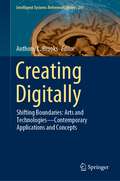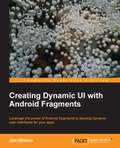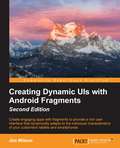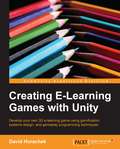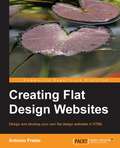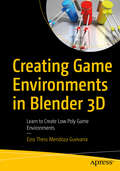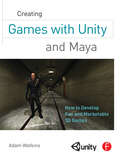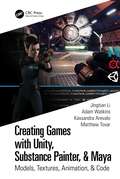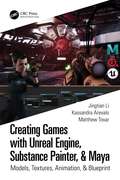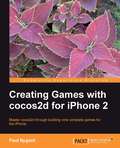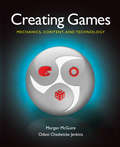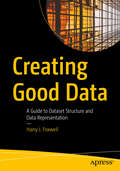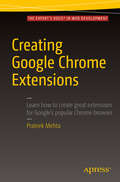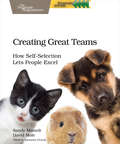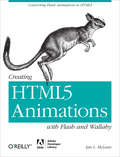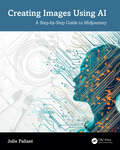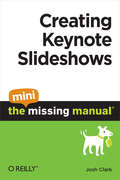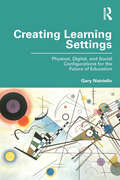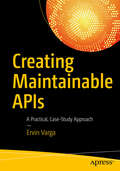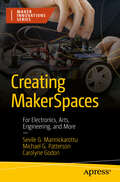- Table View
- List View
Creating Digitally: Shifting Boundaries: Arts and Technologies—Contemporary Applications and Concepts (Intelligent Systems Reference Library #241)
by Anthony L. BrooksThis book of 21 chapters shares endeavors associated to the human trait of creative expression within, across, and between digital media in wide-ranging contexts making the contents perfect as a course study book uptake within related educations. Globally located chapter authors share their comprehensive artisan perspectives from works associated with regional cultures, diversities of interpretations, and widespread scopes of meanings. Contents illustrate contemporary works reflecting thought-provoking comprehensions, functions, and purposes, posit as contributing toward shifting of boundaries within the field. Original to this approach is the reflective offerings on creating digitally beyond typical psychological analysis/rapportage. The book's general scope and key uses are thus to contribute to scholarly discussions toward informing future projects by having an intended wide readership including from within educations, to artisans, and wider interested public.Chapter 7 is available open access under a Creative Commons Attribution 4.0 International License via link.springer.com.
Creating Dynamic UI with Android Fragments
by Jim WilsonA fast-paced tutorial that guides you through everything you need to know about dynamic UI design for Android devices.This book is for developers with a basic understanding of Android programming who would like to improve the appearance and usability of their applications. Whether you're looking to create a more interactive user experience, create more dynamically adaptive UIs, provide better support for tablets and smartphones in a single app, reduce the complexity of managing your app UIs, or you are just trying to expand your UI design philosophy, then this book is for you.
Creating Dynamic UIs with Android Fragments - Second Edition
by Jim WilsonCreate engaging apps with fragments to provide a rich user interface that dynamically adapts to the individual characteristics of your customers' tablets and smartphones About This Book * From an eminent author comes a book that will help you create engaging apps that dynamically adapt to individual device characteristics * The only book that includes the latest fragment-oriented features and their role in Material design * This book provides code-intensive discussions and detailed examples that help you understand better and learn faster. Who This Book Is For This book is for developers with a basic understanding of Android programming who would like to improve the appearance and usability of their applications by creating a more interactive user experience and dynamically adaptive UIs; providing better support for tablets and smartphones in a single app; and reducing the complexity of managing app UIs. What You Will Learn * Learn the role and capabilities of fragments * Use Android Studio's fragment-oriented features * Create an app UI that works effectively on smartphones and tablets * Manage the creation and life cycle of fragments * Dynamically manage fragments using the FragmentTransaction class * Learn the application design for communicating between fragments * Leverage fragments when implementing applications that take advantage of the latest features of Material Design In Detail Today's users expect mobile apps to be dynamic and highly interactive, with rich navigation features. These same apps must look fantastic whether running on a medium-resolution smartphone or high-resolution tablet. Fragments provide the toolset we need to meet these user expectations by enabling us to build our applications out of adaptable components that take advantage of the rich capabilities of each individual device and automatically adapt to their differences. This book looks at the impact fragments have on Android UI design and their role in both simplifying many common UI challenges and in providing best practices for incorporating rich UI behaviors. We look closely at the roll of fragment transactions and how to work with the Android back stack. Leveraging this understanding, we explore several specialized fragment-related classes such as ListFragment and DialogFragment. We then go on to discuss how to implement rich navigation features such as swipe-based screen browsing, and the role of fragments when developing applications that take advantage of the latest aspects of Material Design. You will learn everything you need to provide dynamic, multi-screen UIs within a single activity, and the rich UI features demanded by today's mobile users. Style and approach A fast-paced learning guide that gives a hands-on, code-intensive approach with a focus on real-world applications.
Creating E-Learning Games with Unity
by David HorachekThis book is an easy-to-follow guide that incrementally develops the game framework and missions, step-by-step, with each chapter. Extensive source code is provided and explained in detail to support and explain each of the concepts in the book. This book is intended for novice game programmers with a little experience in Unity3D, who want to learn how to program eLearning games. Educators and trainers who want to use Unity in an eLearning setting will also benefit from the book. It would be helpful to have a basic understanding of the concepts such as Unity scripting and the Finite State Machine (FSM), but no prior experience in game development is required.
Creating Flat Design Websites
by Antonio PratasThis book contains practical, step-by-step tutorials along with plenty of explanation about designing your flat website. Each section is introduced sequentially, building up your web design skills and completing your website. Creating Flat Design Websites is ideal for you if you are starting on your web development journey, but this book will also benefit seasoned developers wanting to start developing in flat.
Creating Game Environments in Blender 3D: Learn to Create Low Poly Game Environments
by Ezra Thess Mendoza GuevarraDiscover how to create a simple game environment in Blender 3D, from modeling and texturing game assets, to placing them in a scene. You’ll export and import game assets as well as look at open-source game engines that will work with your game assets. Creating Game Environments in Blender 3D introduces the power of Blender 3D when creating a low poly game environment. The book starts by discussing the basics of game terminology, such as knowing the difference between low poly and high poly assets and the types of game you’re likely to work on. You’ll also take a brief look at Blender's background and installation. The following chapters talk about the process for creating a simple game environment. This is discussed in detail along with a sample project. These chapters discuss the common tools for starting a game environment and the methods for enhancing your game environment, such as color fundamentals. The final chapter shows how you can export the game assets you created in Blender, how you can import game assets in Blender, and how to evaluate the different game engines available. This book shows you the exciting side of creating a game environment while showing the power of Blender. After reading it, you will feel confident about creating a game environment. What You Will Learn Use Blender to create low poly game environments Work with the common Blender tools for game environment design and development Discover how to use Blender features in depth Compare the Eevee and Cycles game engines Who This Book Is For Game environment artists who want to use Blender 3D to create a game environment. Some previous exposure to game design and development would be helpful, but not required.
Creating Games with Unity and Maya: How to Develop Fun and Marketable 3D Games
by Adam WatkinsUnity brings you ever closer to the "author once, deploy anywhere" dream. With its multiplatform capabilities, you can target desktop, web, mobile devices, and consoles using a single development engine. Little wonder that Unity has quickly become the #1 game engine out there. Mastering Unity is absolutely essential in an increasingly competitive games market where agility is expected, yet until now practical tutorials were nearly impossible to find. Creating Games with Unity and Maya gives you with an end-to-end solution for Unity game development with Maya. Written by a twelve-year veteran of the 3D animation and games industry and professor of 3D animation, this book takes you step-by-step through the process of developing an entire game from scratch-including coding, art, production, and deployment. This accessible guide provides a "non-programmer" entry point to the world of game creation. Aspiring developers with little or no coding experience will learn character development in Maya, scripts, GUI interface, and first- and third-person interactions.
Creating Games with Unity, Substance Painter, & Maya: Models, Textures, Animation, & Code
by Adam Watkins Jingtian Li Kassandra Arevalo Matthew TovarThis tutorial-based book allows readers to create a first-person game from start to finish using industry-standard (and free to student) tools of Unity, Substance Painter, and Maya. The first half of the book lays out the basics of using Maya and Substance Painter to create game-ready assets. This includes polygonal modeling, UV layout, and custom texture painting. The book then covers rigging and animation solutions to create assets to be placed in the game, including animated first-person assets and motion-captured NPC animations. Finally, readers can put it all together and build interactivity that allows the player to create a finished game using the assets built and animated earlier in the book. • Written by industry professionals with real-world experience in building assets and games • Build a complete game from start to finish • Learn what the pros use: construct all assets using the tools used at game studios across the world • All software used are free to students • When complete, students will have a playable version of an FPS game Jingtian Li is a graduate of China’s Central Academy of Fine Arts and New York’s School of Visual Arts, where he earned an MFA in Computer Art. He currently is an Assistant Professor of 3D Animation & Game Design at the University of the Incarnate Word in San Antonio, Texas. Adam Watkins is a 20-year veteran of 3D education. He holds an MFA in 3D Animation and a BFA in Theatre Arts from Utah State University. He currently is the Coordinator and Professor of the 3D Animation & Game Department at the University of the Incarnate Word in San Antonio, Texas. Kassandra Arevalo is an instructor of 3D Animation & Game Design at the University of the Incarnate Word in San Antonio, Texas. She previously worked as an animator at Immersed Games. Matt Tovar is an industry veteran animator. He has worked at Naughty Dog, Infinity Ward, and Sony Interactive on such games as The Last of Us, Call of Duty: Modern Warfare, and most recently Marvel’s Avengers with Crystal Dynamics. He is an Assistant Professor of 3D Animation at the University of the Incarnate Word in San Antonio, Texas.
Creating Games with Unreal Engine, Substance Painter, & Maya: Models, Textures, Animation, & Blueprint
by Jingtian Li Kassandra Arevalo Matthew TovarDescription: This tutorial-based book allows readers to create a first-person game from start to finish using industry-standard (and free to student) tools of Maya, Substance Painter, and Unreal Engine. The first half of the book lays out the basics of using Maya and Substance Painter to create game-ready assets. This includes polygonal modeling, UV layout, and custom texture painting. Then, the book covers rigging and animation solutions to create assets to be placed in the game including animated first-person assets and motion-captured NPC animations. Finally, readers can put it all together and build interactivity that allows the player to create a finished game using the assets built and animated earlier in the book. • Written by industry professionals with real-world experience in building assets and games. • Build a complete game from start to finish. • Learn what the pros use: construct all assets using the tools used at industries across the world. • All software used are free to students. • When complete, students will have a playable version of an FPS game. Jing Tian Li is a graduate of China’s Central Academy of Fine Arts and New York’s School of Visual Arts, where he earned an MFA in Computer Art. He currently is an Assistant Professor of 3D Animation & Game Design at the University of the Incarnate Word in San Antonio, Texas. Kassandra Arevalo is an instructor of 3D Animation & Game Design at the University of the Incarnate Word in San Antonio, Texas. She previously worked as an animator at Immersed Games. Matt Tovar is an industry veteran animator. He has worked at Naughty Dog, Infinity Ward, and Sony Interactive on such games as The Last of Us, Call of Duty: Modern Warfare, and most recently Marvel’s Avengers with Crystal Dynamics. He is an Assistant Professor of 3D Animation at the University of the Incarnate Word in San Antonio, Texas.
Creating Games with cocos2d for iPhone 2
by Paul NygardA hotshot book_10 different cocos2d for iPhone games in increasing order of complexity. Only the barebone structure will be presented without going into the details,If you are an iPhone or iPad developer with base knowledge of cocos2d for iPhone, this book is for you.
Creating Games: Mechanics, Content, and Technology
by Morgan McGuire Odest Chadwicke JenkinsCreating Games offers a comprehensive overview of the technology, content, and mechanics of game design. It emphasizes the broad view of a games team and teaches you enough about your teammates' areas so that you can work effectively with them. The authors have included many worksheets and exercises to help get your small indie team off the ground.
Creating Good Data: A Guide to Dataset Structure and Data Representation
by Harry J. FoxwellCreate good data from the start, rather than fixing it after it is collected. By following the guidelines in this book, you will be able to conduct more effective analyses and produce timely presentations of research data.Data analysts are often presented with datasets for exploration and study that are poorly designed, leading to difficulties in interpretation and to delays in producing meaningful results. Much data analytics training focuses on how to clean and transform datasets before serious analyses can even be started. Inappropriate or confusing representations, unit of measurement choices, coding errors, missing values, outliers, etc., can be avoided by using good dataset design and by understanding how data types determine the kinds of analyses which can be performed. This book discusses the principles and best practices of dataset creation, and covers basic data types and their related appropriate statistics and visualizations. A key focus of the book is why certain data types are chosen for representing concepts and measurements, in contrast to the typical discussions of how to analyze a specific data type once it has been selected. What You Will Learn Be aware of the principles of creating and collecting dataKnow the basic data types and representationsSelect data types, anticipating analysis goalsUnderstand dataset structures and practices for analyzing and sharingBe guided by examples and use cases (good and bad)Use cleaning tools and methods to create good data Who This Book Is For Researchers who design studies and collect data and subsequently conduct and report the results of their analyses can use the best practices in this book to produce better descriptions and interpretations of their work. In addition, data analysts who explore and explain data of other researchers will be able to create better datasets.
Creating Google Chrome Extensions
by Prateek MehtaTransform your existing web applications into Google Chrome browser extensions and create brand new extensions that improve your own browsing experience and that of your users. This book shows you how Google Chrome browser extensions are extremely useful tools for enhancing the functionality of the Google Chrome web browser. For example, you can create extensions to summarize the current page you are reading, or to save all of the images in the page you are browsing. They have access to almost all of the features provided by the Google Chrome browser, and they can encapsulate such features in the form of a bundled application providing targeted functionality to users. Extensions also run in a sandboxed environment, making them secure - which is a huge plus in the modern web! The APIs provided by the Chrome Extensions framework help you empower web applications by coupling them with amazing features provided by the Google Chrome web browser, such as bookmarks, history, tabs, actions, storage, notifications, search, and a lot more - facilitating increased productivity on the Google Chrome web browser. What you'll learn Transform your web application ideas into Google Chrome extensions Choose the recommended components for creating your kind of extension Leverage the power of a Google Chrome browser by making use of the extensions API Showcase your existing web-development skills in a modern way by creating useful extensions. Who this book is for Creating Google Chrome Extensions is for existing web developers, experienced in creating simple web pages (using HTML, CSS, and JavaScript), to help them create browser extensions for Google Chrome. After understanding the examples and lessons in this book, you will be able to transform your existing web applications into Google Chrome browser extensions, as well as create brand new extensions.
Creating Great Teams: How Self-Selection Lets People Excel
by Sandy Mamoli David MolePeople are happiest and most productive if they can choose what they work on and who they work with. Self-selecting teams give people that choice. Build well-designed and efficient teams to get the most out of your organization, with step-by-step instructions on how to set up teams quickly and efficiently. You'll create a process that works for you, whether you need to form teams from scratch, improve the design of existing teams, or are on the verge of a big team re-shuffle. Discover how New Zealand's biggest e-commerce company completely restructured their business through Self-Selection. In the process, find out how to create high-performing groups by letting people self-organize into small, cross-functional teams. Step-by-step guides, easy-to-follow diagrams, practical examples, checklists, and tools will enable you to run a Self-Selection process within your organization.If you're a manager who wants to structure your organization into small teams, you'll discover why Self-Selection is the fastest and safest way to do so. You'll prepare for and organize a Self-Selection event and make sure your Self-Selection participants and fellow managers are on board and ready. If you're a team member, you'll discover what it feels like to be part of a Self-Selection process and what the consequences are for your daily work. You'll learn how to influence your colleagues and bosses to be open to the idea of Self-Selection. You'll provide your manager with a plan for how to facilitate a Self-Selection event, and with evidence that the system works.If you're feeling the pain and chaos of adding new people to your organization, or just want to ensure that your teams have the right people with the right skills, Self-Selection will help you create the effective teams you need.
Creating HTML5 Animations with Flash and Wallaby: Converting Flash Animations to HTML5 (Oreilly And Associate Ser.)
by Ian L. McLeanCreating standards-compliant animations for the Web just got a lot easier. With this concise guide, you’ll learn how to convert Flash animations into HTML5, using Wallaby—the experimental tool from Adobe. Wallaby makes Flash content available for devices that don't support Flash runtimes, including the iPhone and iPad.Developing HTML5 animations is time-consuming with all the coding required. This book shows you how to create compelling content for HTML5 environments with relative ease, whether you know Flash or not. After a quick introduction to simple animation building with Flash, you'll learn how Wallaby helps you convert those animations into HTML5 code.Learn how to create a simple Flash animation, using Flash Professional CS5Become familiar with the Flash Library, Stage drawing canvas, and animation TimelineTake the right approach to building a complex Flash animation for HTML5Get performance tips to optimize animations for desktops and mobile devicesUse simple JavaScript and CSS code to place the Wallaby animation in a web pageAdd interactivity to your HTML5 animation with jQuery
Creating High-Quality Vegetation for Games
by Chico SpansThis is a start-to-finish guide on how to build high-quality vegetation for video games. This book gives readers the fundamentals of the craft and the skills needed to confidently create natural environments.Chapters cover everything from planning and gathering references, creating natural-looking ground cover with lots of variety, and building trees procedurally, to setting up a realistic wind shader before combining all assets into a scene in Unreal Engine 5.This book will be of interest to all beginner and aspiring environment and vegetation artists looking to learn how to create high-quality vegetation, as well as more experienced artists looking to hone their craft.
Creating Images Using AI: A Step-by-Step Guide to Midjourney
by Julie PallantCreating Images Using AI: A Step-by-Step Guide to Midjourney is an essential resource for professionals and others looking to harness the amazing power of AI-powered image generator programs and to ensure they keep up to date with developments in this rapidly evolving field. This comprehensive guide offers an in-depth exploration of Midjourney, one of the most respected programs available today, used by over 17 million users.The book covers the fundamentals of setting up and using Midjourney through to advanced techniques for crafting precise text- and image-based prompts to ensure high-quality images. Detailed step-by-step instructions are provided to facilitate a thorough understanding of the program, supported throughout by screenshots and examples of Midjourney image output. Included are case studies of talented artists who use Midjourney as a creative tool, with examples of their inspiring art to motivate readers. A dedicated chapter offers resources for photographers, designers, and artists to expand their skills, and to stay up to date with the latest developments in AI technology.Whether you're seeking to enhance your professional toolkit or simply explore AI as a creative outlet, this book offers the knowledge and skills to harness Midjourney’s full potential. For professionals in photography, graphic design, marketing, advertising, and education, it provides the essential tools to stay ahead in a rapidly changing industry.
Creating Infographics with Adobe Illustrator: 2D and 3D Graphics
by Jennifer HarderThis full-color book will teach you how to use Adobe Illustrator's various tools to create infographics, as well as basic page layouts for them. It focuses on Illustrator’s powerful graphing tools and 2D and 3D effects. How can an infographic or graph be altered and adapted to appear more engaging and still display your data accurately? What additional effects can be used on your infographic to produce the results you envision? In this second volume of Creating Infographics with Adobe Illustrator, you will learn the answers to all these questions. Author Jennifer Harder will walk you through creating basic infographics in Illustrator using Illustrator tools such as Graphing Tools as well as how to create 2D effects and 3D shapes with their related materials, including Symbols. Upon completing this volume, you will have an appreciation for how easy it is to design an infographic or graph to display your data and discover how rudimentary shapes and colors can be altered using patterns, as well as 2D and 3D effects, to enhance readability while conveying meaning to your audience. You will be able to use this knowledge to create your own infographics using Illustrator’s wide array of tools. What You Will Learn Use Illustrator’s Graphing Tools to create and modify basic charts or graphsWork with popular 2D effects to enhance your design in IllustratorCreate 3D Shapes using Materials and Symbols and modify your 3D GraphsExplore basic Image Trace and Perspective options in Illustrator Who This Book Is For Beginner-level designers and others who are interested in learning the process of creating infographics for their company, the classroom, for data visualization, an article in a magazine, or a webpage.
Creating Infographics with Adobe Illustrator: Interactive Infographics and the Creative Cloud
by Jennifer HarderThis full-color book, the third of three volumes, focuses on Adobe Illustrator’s SVG interactivity tools. How can an infographic be made more interactive for an audience? What additional Illustrator tools and Adobe applications can be used to enhance your infographic layout? In this final volume of Creating Infographics with Adobe Illustrator, you will learn the answers to all these questions. Author Jennifer Harder will walk you through creating basic infographics in Illustrator using Illustrator tools for creating SVG files, known as Scalable Vector Graphics, for basic Interactivity on a web page. Then you will review layouts in other Adobe Applications in relation to their connectivity with Illustrator. Upon completing this volume, you will have a thorough understanding of how to design an infographic with basic interactivity for a web page, and how this can improve visualization and convey meaning to your audience. Moreover, you will be able to use this knowledge to create your own infographics using Illustrator’s wide array of tools. What You Will Learn Discover how to apply interactivity to an infographicGain insight into different infographic layouts and how to finalize your project with your clientExplore other Adobe Creative Cloud applications that may assist you in the future as you create your infographics Who This Book Is For Beginner-level designers and others who are interested in learning the process of creating infographics for their company, the classroom, for, an article in a magazine, or adding interactivity to webpage.
Creating Infographics with Adobe Illustrator: Learn the Basics and Design Your First Infographic
by Jennifer HarderThis full-color book will teach you how to use Adobe Illustrator's various tools to create infographics, as well as basic page layouts for them. This is the first of three volumes which will cover all the fundamentals of Illustrator, an industry standard application used by graphic designers and marketing and communication teams. How is an infographic different from a logo or any other illustration? What additional thought processes, skills, or software tools should be utilized to create an infographic? In this first volume of Illustrator Basics, you will learn the answers to all these questions. Author Jennifer Harder will walk you through creating basic infographics in Illustrator using Basic Shape tools, Pen Tools, Type Tools, and Symbols. Upon completing this volume, you will have an appreciation for how easy it is to design an infographic and discover how rudimentary shapes and colors can affect readability while conveying meaning to your audience. You will be able to use this knowledge to create your own infographics using Illustrator’s wide array of tools. Who This Book Is For Discover the tools within Illustrator that are ideal for creating basic infographicsDevelop a logo based upon a scanned sketchGain an understanding of different infographic layouts and the process of reviewing them with your client Who This Book Is For Beginner-level designers and others who are interested in learning the process of creating infographics for their company, the classroom, for a visual resume, an article in a magazine, or a webpage.
Creating Keynote Slideshows: The Mini Missing Manual
by Josh ClarkDon't bore your audience with black bullet points on a white background. Your ideas deserve a presentation that's as smart and elegant as they are. Even if you're new to the Mac, this hands-on guide gets you up to speed on Keynote's features-like time saving themes- fast. You'll learn how to customize layouts to your liking and add even more flash with sound and video.
Creating Keynote Slideshows: The Mini Missing Manual
by Josh ClarkDon't bore your audience with black bullet points on a white background. Your ideas deserve a presentation that's as smart and elegant as they are. Even if you're new to the Mac, this hands-on guide gets you up to speed on Keynote's features-like timesaving themes-fast. You'll learn how to customize layouts to your liking and add even more flash with sound and video.
Creating Learning Settings: Physical, Digital, and Social Configurations for the Future of Education
by Gary NatrielloCreating Learning Settings examines the design and implementation of learning settings informed by the newest, most expansive insights into how people learn in the post-industrial age. Educators today are tasked with moving beyond the fixed, traditional practices that have long dominated formal schooling and becoming more dynamic and strategic in arranging learners, facilitators, resources, on-site and virtual environments, and learning experiences. Integrating contemporary theoretical approaches and empirical studies, this book offers a systematic approach to creating settings that leverage the physical, digital, resource, and social dimensions necessary to support learning.
Creating Maintainable APIs: A Practical, Case-Study Approach
by Ervin VargaBuild straightforward and maintainable APIs to create services that are usable and maintainable. Although this book focuses on distributed services, it also emphasizes how the core principles apply even to pure OOD and OOP constructs. The overall context of Creating Maintainable APIs is to classify the topics into four main areas: classes and interfaces, HTTP REST APIs, messaging APIs, and message payloads (XML, JSON and JSON API as well as Apache Avro). What You Will Learn Use object-oriented design constructs and their APIs Create and manage HTTP REST APIs Build and manage maintainable messaging APIs, including the use of Apache Kafka as a principal messaging hub Handle message payloads via JSON Who This Book Is For Any level software engineers and very experienced programmers.
Creating MakerSpaces: For Electronics, Arts, Engineering, and More (Maker Innovations Series)
by Sevile G. Mannickarottu Michael G. Patterson Carolyne GodonStart your own MakerSpace and foster a robust and resilient place for Makers to grow and develop their skills. This book is the perfect guide for those interested in building and making, using a knowledge of art, biology, electronics, or mechanical work. It&’s not enough to just buy a few 3D printers or have some electronics. MakerSpaces span a variety of areas, including art, biology, chemistry, electronics, and mechanics. As you start one, you need to make sure you have the right tools, the right supplies, and the right operation. First, you&’ll explore the variety of tools and supplies available, from low-cost to expensive, and see how to use them. Then select the best tools for your MakerSpace, whether for a library, a school, or to open-up to a community. The next phase is operating a MakerSpace. We&’ll explore how to lay out your space, control access, and provide training. In addition, this book offers suggestions on how to manage your staff, whether part-time, full-time, or volunteers. Creating MakerSpaces is your pathway to a safe, well-maintained, and great environment for Makers in your community! What You'll Learn Source the skills you need to help your community of Makers Manage your MakerSpace effectively once it&’s set up Provide the right training to use and maintain your space safely Who This Book Is For Anyone interested in starting a MakerSpace
